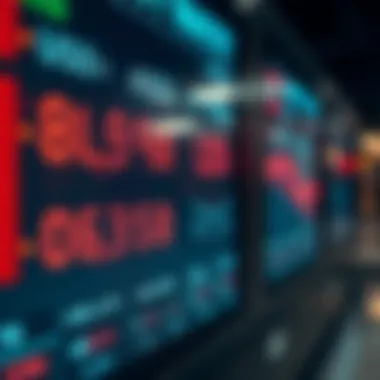Converting 80000 USD to AED: Key Insights


Intro
Converting currencies is no simple task, especially when dealing with substantial amounts like 80,000 USD to AED. Navigate this process without a rigmarole can be crucial for potential investors who eye the opportunities within Dubai's thriving real estate market. Investors, whether seasoned or fresh to the scene, need to grasp the nuances of exchange rates, market trends, and specific factors that affect these metrics.
In an environment as dynamic as that of the United Arab Emirates, one must look beyond mere numbers. The ebb and flow of currencies often mirror economic conditions, geopolitical shifts, and even local market sentiments. Thus, embracing a meticulous understanding of currency exchange not only aids in personal finance decisions but also serves as a roadmap for making sound investment choices.
In the coming sections, we will break down the current market trends, shed light on investment insights, and what prospective buyers should consider when converting their dollar amount into dirhams. Let's dive deep into this financial landscape.
Prelims to Currency Conversion
Currency conversion is not just a mundane transaction but a fundamental aspect of global finance. It informs how individuals, businesses, and governments alike engage in the economic exchange of value. In our increasingly interconnected world, understanding how to convert currencies accurately is essential for making informed decisions, especially for investors and travelers.
The Importance of Currency Rates
Currency rates act like the pulse of global finance. They fluctuate constantly due to various factors, including economic data, market speculation, and geopolitical events. For someone converting 80,000 USD to AED, grasping the significance of these rates becomes critical. A slight movement in the rate can alter the amount received significantly. As a result, one must always stay updated on current exchange rates and understand market patterns.
Moreover, currency rates serve as indicators of a country's economic health. When the rate of the USD rises against AED, it may reflect the strength of the U.S. economy or a weakness in the Gulf economy or vice versa. For investors, these insights can guide strategic decisions in areas such as real estate and import-export businesses.
USD and AED Overview


The U.S. Dollar (USD) and the United Arab Emirates Dirham (AED) are prominent currencies in the global market. The USD is often seen as the world's reserve currency, widely used for international trade and held by central banks as a stable asset. On the other hand, the AED is pegged to the USD, which means that its value is closely tied to the performance of the U.S. currency. This peg helps maintain stability in the UAE's economy and fosters confidence among foreign investors.
The current exchange mechanism also allows investors to easily navigate the currency conversion process. Having a clear understanding of how the USD/AED relationship works is vital, as it provides a framework for assessing market conditions and making sound financial choices. In addition, businesses looking to operate in the UAE market must also consider the implications of these rates on their budgets and pricing strategies. With the local economy rapidly becoming a hub for various sectors, this knowledge is imperative for sustaining competitive advantage.
Understanding Exchange Rate Dynamics
When dealing with the exchange of 80,000 USD to AED, understanding the dynamics of exchange rates is crucial. This knowledge equips investors and property seekers with the ability to navigate the financial terrain of currency fluctuations effectively. Grasping how exchange rates function can help individuals anticipate market movements, optimize conversion rates, and ultimately make better financial decisions.
Exchange rates can be influenced by a myriad of factors, and recognizing these can provide valuable insights into potential profit and loss scenarios. Knowing whether the rate is likely to rise or fall in the short term becomes important for timing conversions accurately. Investments in real estate, especially in a dynamic market like Dubai, are significantly affected by these rates. Thus, delving deep into exchange rate dynamics can not only save money but also help in capitalizing on timely opportunities.
Factors Influencing Exchange Rates
Interest Rates
Interest rates play a pivotal role in shaping exchange rates directly. They refer to the cost of borrowing money, and when interest rates in a country rise, it often leads to an appreciation of that country’s currency. This happens because higher rates offer better returns on investments denominated in that currency, enticing investors globally. Therefore, when considering converting 80,000 USD to AED, it’s wise to keep an eye on interest trends.
A key characteristic of interest rates is their influence on foreign investment. A rise in interest rates typically attracts foreign capital, leading to a stronger currency. However, high interest rates can also pose challenges, particularly for individuals looking to borrow or buy properties. While the weight of these rates can sway the conversion rates, they often reflect broader economic health, making them a critical factor to consider in this article.
Inflation Rates


Inflation rates are another important element in the currency exchange equation. Inflation reflects the rate at which prices for goods and services rise, eroding purchasing power. When one country experiences higher inflation than another, its currency tends to depreciate in value relative to that other currency. Sticking with the USD to AED conversion, if the US faces soaring inflation, the value of the USD will likely drop compared to the relatively stable AED.
One key feature of inflation rates is their potential to galvanize central banks into action, often leading to adjustments in monetary policy. For investors, higher inflation can mean a less attractive environment for their investments, thereby influencing their decisions on when to exchange currencies. A deep understanding of inflation can help investors mitigate risks associated with currency depreciation over time, making it a fundamental aspect of any currency exchange discussion.
Political Stability
Political stability is often an underappreciated factor influencing exchange rates, yet it carries significant weight. In essence, countries with stable political environments tend to attract more foreign investments, which in turn strengthens their currency. On the flip side, political upheaval or uncertainty can lead to erratic currency movements, often triggering a rush of investors seeking safety in more stable currencies.
A key characteristic of political stability is its ability to foster economic confidence. This confidence encourages investments, leading to better economic outcomes. For anyone looking to convert USD to AED, understanding the political climate within both the US and UAE is crucial. A country’s political landscape can drastically flip the script on exchange rates, making it imperative to stay informed.
Historical Trends of USD to AED Rates
Examining the historical trends of USD to AED rates provides context and perspective on current market conditions. Over the years, the relationship between these two currencies has shown a wide range of variability from periods of appreciation to depreciation. By analyzing these patterns, investors can form a clearer picture of potential outcomes that might arise from currency exchange.
Specific historical events, such as economic crises or major geopolitical developments, have sometimes had profound impacts on the USD/AED exchange rate.
Such insights not only inform investors but also prepare them for anticipating future shifts in the currency landscape, thereby facilitating more strategic decision-making in currency exchanges. Key resources for tracking these trends include financial data providers and economic reports from central banks.
Calculating the Conversion


Calculating currency conversion isn't simply about exchanging one unit of value for another. It serves as a vital component in comprehending the true financial implications behind investment decisions, especially considering substantial amounts like 80,000 USD. Understanding the intricate process of currency conversion is crucial for investors and homebuyers who wish to navigate the highs and lows of the Dubai real estate market.
When dealing with foreign exchange, several elements come into play. First, you have the exchange rate. Understanding how it fluctuates and what influences these changes can significantly affect your purchasing power in a different currency, in this case, the United Arab Emirates Dirham (AED). The exchange rate does not just dictate the conversion amount; it can also signal broader economic trends that might impact your investment.
Another key factor involves transaction fees, which can chip away at the amounts you're converting, seemingly unnoticed, until the final figures come through. Furthermore, knowing when to exchange your currency can make a notable difference in your overall investment strategy. This leads to essential considerations for anyone thinking about diving into the market, particularly for investors eyeing opportunities in Dubai.
Current Exchange Rates
To start your conversion journey, being in the know about the current exchange rates is essential. As of the latest updates, the exchange rate can fluctuate. For instance, if the current rate is about 3.67 AED for 1 USD, that might seem favorable at first glance. However, these numbers can swing dramatically with market changes, influenced by factors like oil prices, global economic conditions, and local market sentiment.
"The pulse of the market often beats faster than we realize, and knowing the current exchange rate can make the difference between a savvy investment and a financially struggling venture."
It might be beneficial to check reliable sources like XE.com or Forex for the latest rates. Also, consider checking local banks as they might offer different rates based on their operational costs and profit margins.
Practical Calculation for USD
Now, let’s put the numbers into perspective. Converting 80,000 USD into AED when the exchange rate is 3.67 AED/USD results in a straightforward calculation:
80,000 USD * 3.67 AED/USD = 293,600 AED
293,600 AED - (1% of 293,600 AED) = 290,664 AED



